Are you looking for the cutest animals on earth? Look no further! We have compiled a list of the top 10 cutest animals according to various sources.
From the red panda to the quokka, these animals are sure to melt your heart with their adorable faces and playful personalities. Keep reading to find out more about these cute creatures and where you can see them in the wild.
You are reading: The Top 10 Cutest Animals On Earth
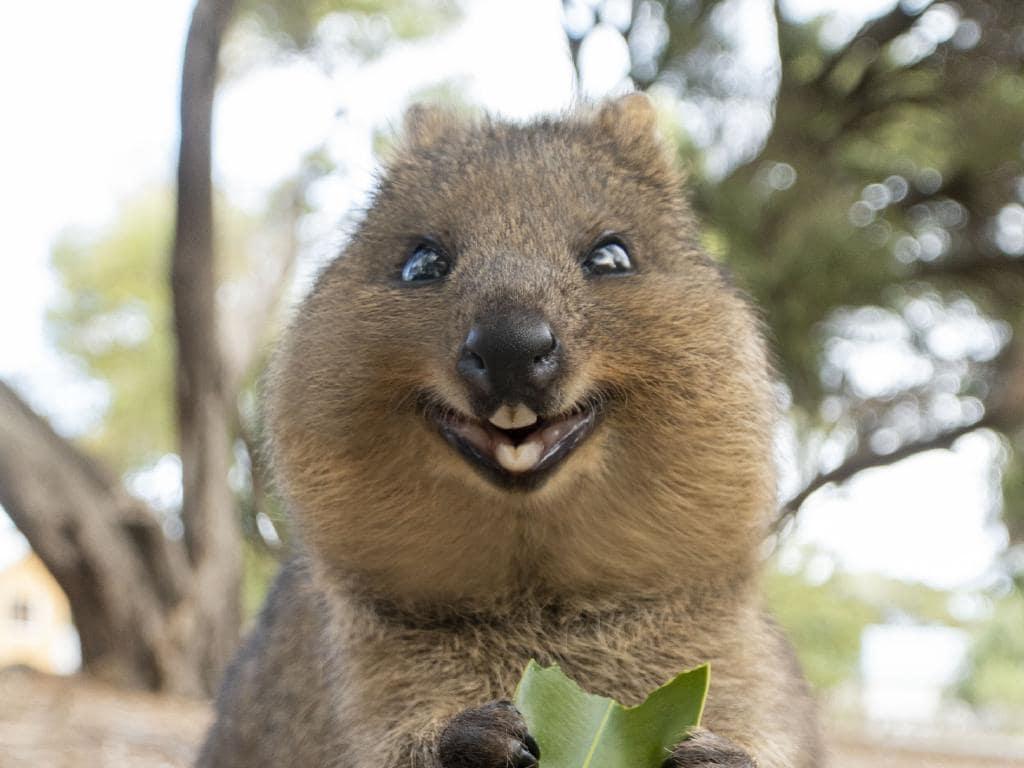
The Top 10 Cutest Animals On Earth
Red Panda

The red panda, also known as the lesser panda, is a small mammal native to the eastern Himalayas and southwestern China.
It has dense reddish-brown fur with a black belly and legs, white-lined ears, a mostly white muzzle, and a ringed tail. The red panda is slightly larger than a domestic cat with a bear-like body and thick russet fur. Its head-to-body length is 51–63.5 cm (20.1–25.0 in) with a 28–48.5 cm (11.0–19.1 in) tail, and it weighs between 3.2 and 15 kg (7.1 and 33.1 lb) .
The red panda is well adapted to climbing due to its flexible joints and curved semi-retractile claws. It is a skillful and acrobatic animal that predominantly stays in trees.
The red panda’s coat is mainly red or orange-brown with a black belly and legs. The muzzle, cheeks, brows, and inner ear margins are mostly white while the bushy tail has red and buff ring patterns and a dark brown tip. The colouration appears to serve as camouflage in habitat with red moss and white lichen-covered trees.
Red pandas live mostly in cool, temperate forests with a shrubby understory dominated by thick bamboo. They prefer habitats with plenty of fallen logs, tree branches, and bamboo.
The loss of nesting trees and bamboo is causing a decline in red panda populations across much of their range because their forest home is being cleared. The Red Panda Network is committed to the conservation of wild red pandas and their habitat through the education and empowerment of local communities.
Koala
The koala, also known as the koala bear, is an arboreal herbivorous marsupial native to Australia. It is the only extant representative of the family Phascolarctidae and its closest living relatives are the wombats. Koalas are found in coastal areas of the mainland’s eastern and southern regions, inhabiting Queensland, New South Wales, Victoria, and South Australia.
They are a stocky animal with a large head and vestigial or non-existent tail. They have a body length of 60–85 cm (24–33 in) and a weight of 4–15 kg (9–33 lb), making them among the largest arboreal marsupials.
Koalas from Victoria are twice as heavy as those from Queensland. The species is sexually dimorphic, with males 50% larger than females. Males are further distinguished from females by their more curved noses and the presence of chest glands, which are visible as hairless patches.
Koalas are an integral part of the Australian bush, perched high up in the branches of gum trees sleeping for up to 20 hours a day. They have two opposing thumbs on their hands, and both their feet and hands have rough pads and claws to grab onto branches. They have two toes, fused together, on their feet, which they use to comb their fur.
Koalas live in the eucalyptus forests of southeastern and eastern Australia. When not sleeping, they’re usually eating. They rely on the eucalyptus tree for both habitat and food. Koalas can eat more than a pound of eucalyptus leaves a day.
The koala is the quintessential Australian animal, known globally and much loved. People come from all over the world to see koalas at wildlife parks and zoos. They are featured in advertisements, games, cartoons, and as soft toys.
Meerkat
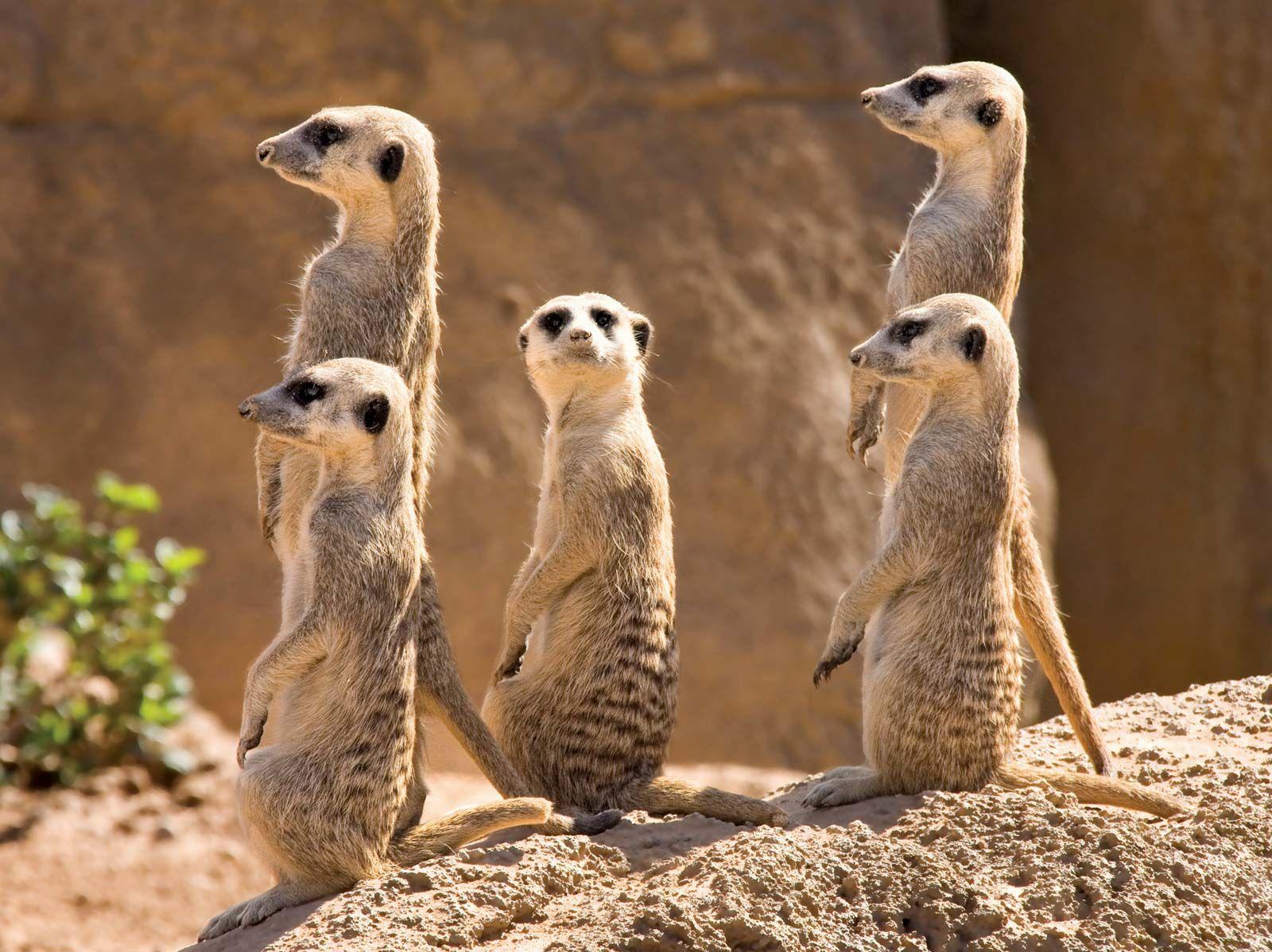
Meerkats are small mammals that belong to the mongoose family. They are found inhabiting the harsh conditions of the open and arid, semi-desert plains in southern Africa.
Meerkats are known for their sociable behavior, living in groups larger than pairs, which is unusual for mongoose species. They have a long and slender body with a long and light but black-tipped tail that can almost double the animal’s total length.
Meerkats are sandy to light brown in color with eight darker stripes on their back, markings on their sides (which are unique to the individual) and a lighter face and underside. They have elongated muzzles with black noses and dark-colored bands around their eyes.
Meerkats have powerful foreclaws for digging and pointed snouts that help them excavate prey from narrow trenches. They are slender animals, with a body length of 25 to 35 centimeters and a tail length of 18 to 25 centimeters.
Meerkats live in southern Africa, including South Africa, Botswana, Zimbabwe, and Mozambique, in dry, open plains, savannas, and grasslands. They are active carnivores that primarily eat insects, such as grubs and termites, but will also eat small reptiles, birds, eggs, fruit, and plants.
Meerkats are gregarious and have at least ten distinctive vocalizations, including murmurs, threatening growls and spits, scolding clucks, and a defensive alarm bark.
Pygmy Marmoset
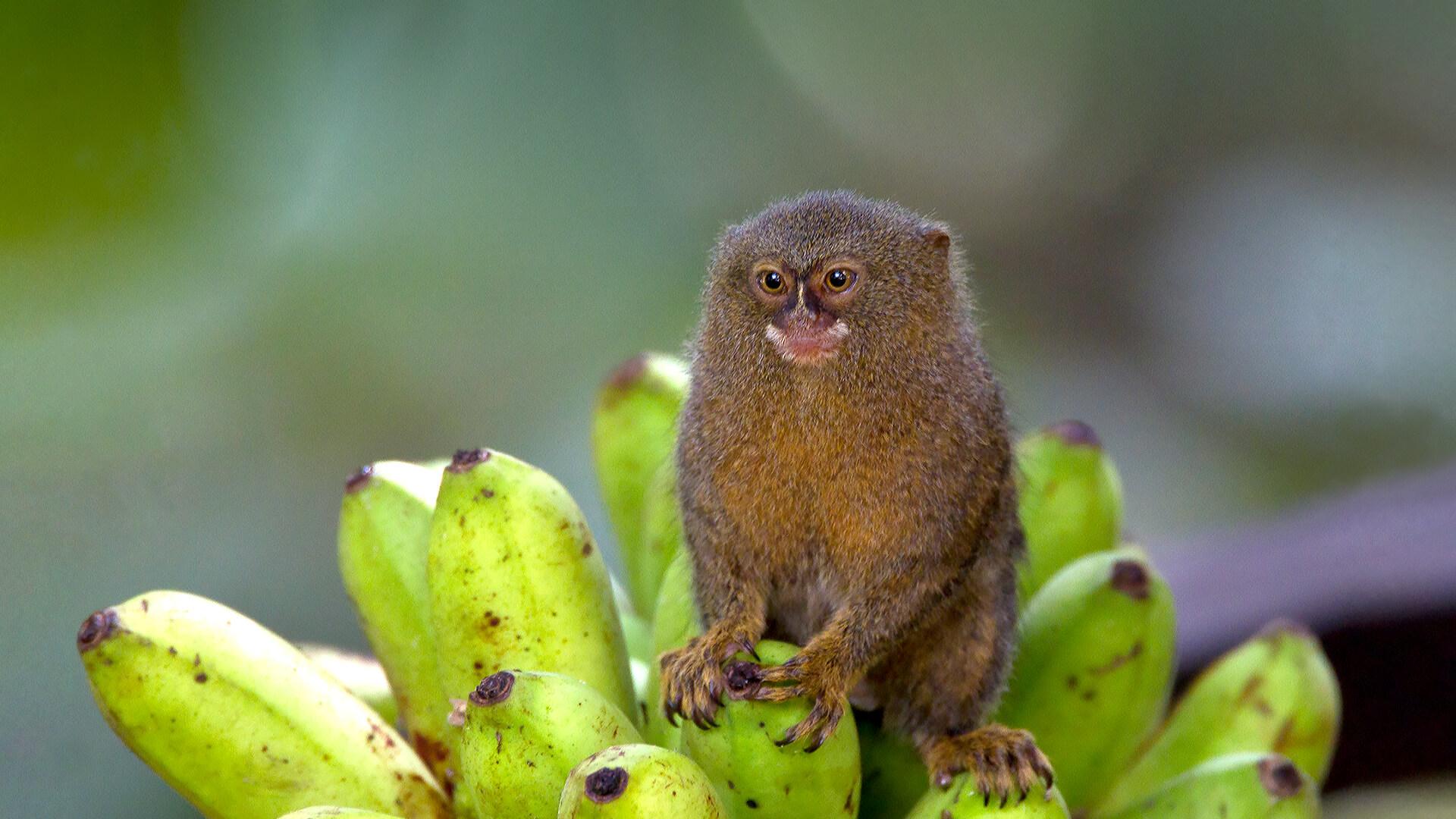
The Pygmy Marmoset, also known as the finger monkey, is a small New World monkey native to the rainforests of the western Amazon Basin in South America. It is one of the smallest primates in the world, with a body length of 4 to 6 inches and a weight of a little over 4 ounces.
Pygmy marmosets are arboreal and diurnal animals, active during cooler mornings and late afternoons. They are highly social primates, gathering into stable groups of 2-15 marmosets, which are normally family troops consisting of a breeding pair and their young. When sleeping at night, they usually huddle together in dense vine growth at heights of about 7-10 meters.
Pygmy marmosets are herbivorous and carnivorous animals, feeding on a wide variety of food such as nectar, fruit, leaves, insects, and gum or tree sap, which is their primary type of food.
The Pygmy marmoset is common and widespread throughout its range, but its numbers are decreasing due to habitat loss and the pet trade.
Hedgehog
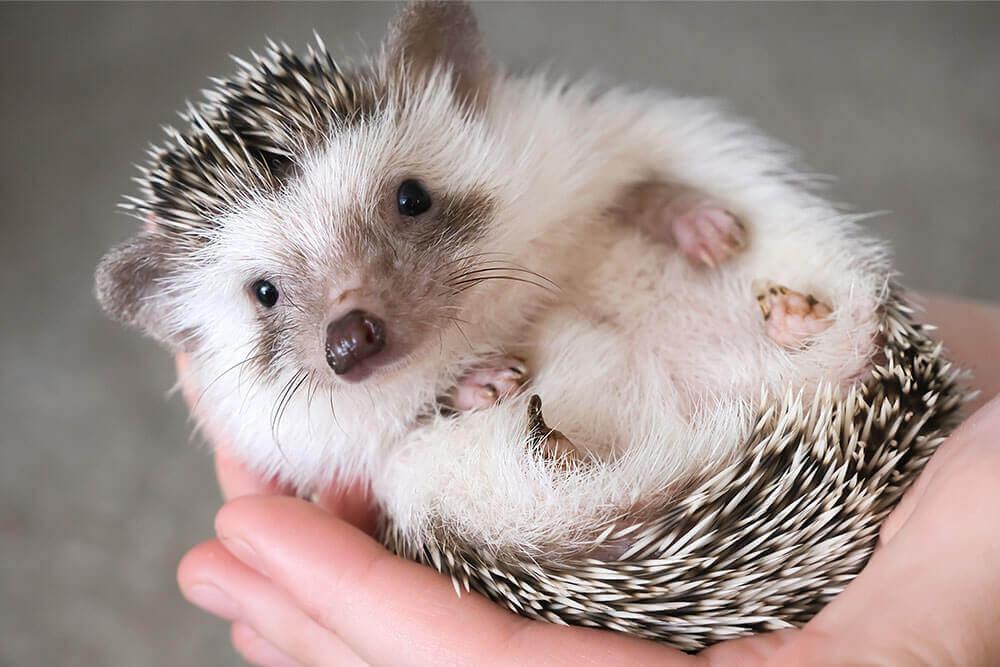
Hedgehogs are small, spiny mammals that belong to the subfamily Erinaceinae, in the eulipotyphlan family Erinaceidae. They are found throughout parts of Europe, Asia, and Africa, and in New Zealand by introduction.
Hedgehogs are easily recognized by their spines, which are hollow hairs made stiff with keratin. Their spines are not poisonous or barbed and, unlike the quills of a porcupine, do not easily detach from their bodies. Hedgehogs are not rodents, and they do not have a propensity to chew, gnaw on, or destroy their surroundings.
Hedgehogs are nocturnal animals that root through hedges and other undergrowth in search of the small creatures that compose the bulk of their diet—insects, worms, centipedes, snails, mice, frogs, and snakes.
Hedgehogs have a coat of stiff, sharp spines. If attacked, they will curl into a prickly and unappetizing ball that deters most predators.
Hedgehogs are losing their living spaces due to human activities such as agricultural activities, expanding settlements, and constructing road Hedgehogs are useful pets because they prey on many common garden pests. While on the hunt, they rely upon their senses of hearing and smell because their eyesight is weak.
Otter
Otters are fascinating mammals that are found in various aquatic environments around the world.
There are 13 extant otter species, all of which are semiaquatic, aquatic, or marine, with diets based on fish and invertebrates. The Asian small-clawed otter is the smallest otter species, while the giant otter and sea otter are the largest.
Otters have very soft, insulated underfur, which is protected by an outer layer of long guard hairs. This traps a layer of air which keeps them dry, warm, and somewhat buoyant under water. Otters are carnivorous mammals that feed on fish, invertebrates, and other small aquatic animals.
Otters are excellent swimmers, with webbed feet and powerful tails that act like rudders. Their nostrils and ears close to keep water out, and waterproof fur keeps them warm. Otters are known for their playful behavior and are often seen sliding down muddy banks or snow-covered hills.
Otters are losing their living spaces due to human activities such as agricultural activities, expanding settlements, and constructing roads. Otters are important to their ecosystems because they help control populations of prey species and are indicators of ecosystem health.
Otters have been known to attack humans, but this is rare and usually only occurs when the otter feels threatened or cornered.
Chevrotain
The chevrotain, also known as the mouse-deer, is a small, shy, and elusive ungulate that belongs to the family Tragulidae.
Chevrotains are found in the warmer parts of Southeast Asia and India and in parts of Africa. They are classified into the genera Hyemoschus, Moschiola, and Tragulus.
Chevrotains stand about 30 cm (12 inches) tall at the shoulder and characteristically walk on the hoof tips of their slender legs. The fur of chevrotains is reddish-brown with spots and stripes of paler color or white, and the underside is pale. The males have small curved tusks protruding downward out of the mouth from the upper jaw.
Chevrotains are shy, solitary, evening- and night-active vegetarians. The water chevrotain (Hyemoschus aquaticus), larger than the Asian forms, is found in western equatorial Africa. It inhabits thick cover on the banks of rivers and, when disturbed, seeks escape in the water.
In November 2019, conservation scientists announced that they had photographed silver-backed chevrotains (Tragulus versicolor) in a Vietnamese forest for the first time since the last confirmed sightings in 1990.
Chevrotains are losing their living spaces due to human activities such as agricultural activities, expanding settlements, and constructing roads. Thry are important to their ecosystems because they help control populations of prey species and are indicators of ecosystem health.
Sea Otter
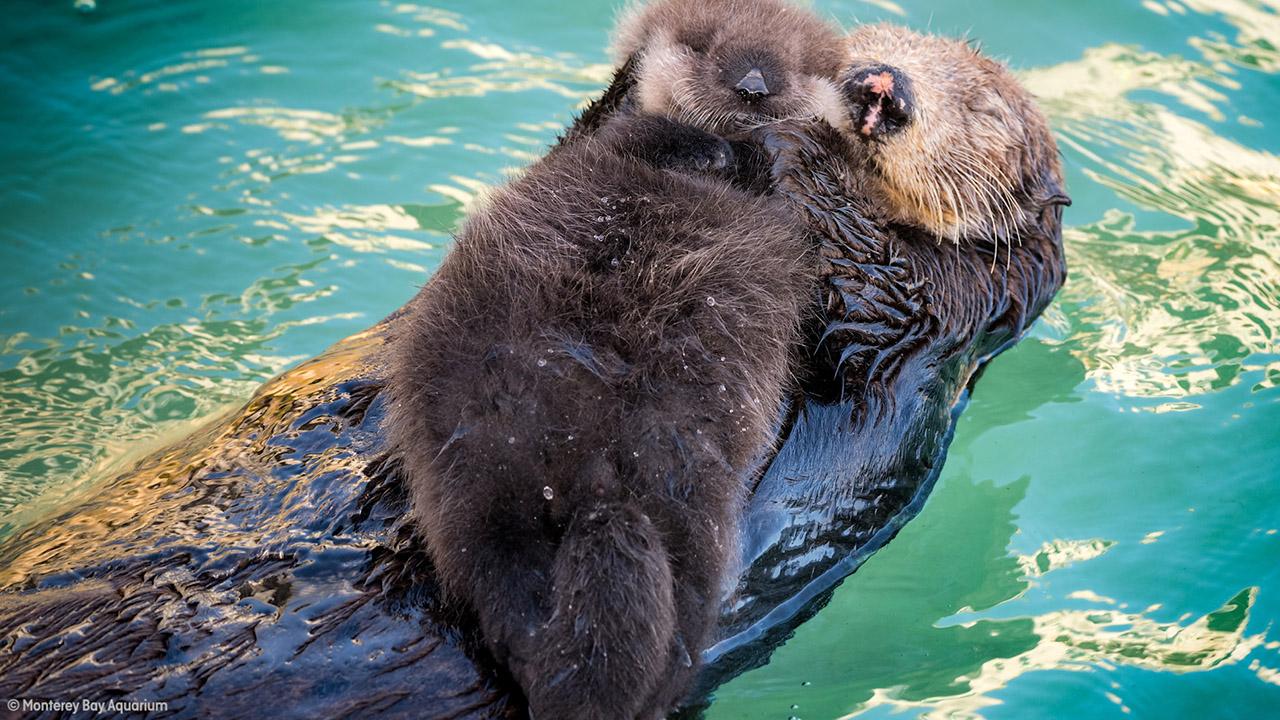
Read more : The Top 10 Incredible Animals That Live In Coral Reefs
Sea otters are fascinating marine mammals that are native to the coasts of the northern and eastern North Pacific Ocean.
Sea otters are the heaviest members of the weasel family, but among the smallest marine mammals. Adult sea otters typically weigh between 14 and 45 kg (30 and 100 lb). Unlike most marine mammals, the sea otter’s primary form of insulation is an exceptionally thick coat of fur, the densest in the animal kingdom.
They are the only marine mammals that do not have a layer of blubber to keep them warm. Instead, they rely on their dense fur to keep them warm.
Sea otters are a keystone species, meaning they play a crucial role in maintaining the health and stability of the nearshore marine ecosystem. Sea otters spend most of their time in the water but, in some locations, come ashore to sleep or rest. They often float at the water’s surface, lying on their backs in a posture of serene repose. They sleep this way, often gathered in groups.
Sea otters have webbed feet, water-repellent fur to keep them dry and warm, and nostrils and ears that close in the water. Sea otters are carnivores, feeding on a variety of prey such as sea urchins, crabs, squid, octopuses, and fish. They use rocks to help them open mussels or other shellfish.
Sea otters are the only otters to give birth in the water. Mothers cuddle their young while floating on their backs and hold infants on their chests to nurse them. They quickly teach them to swim and hunt for themselves.
Fennec Fox
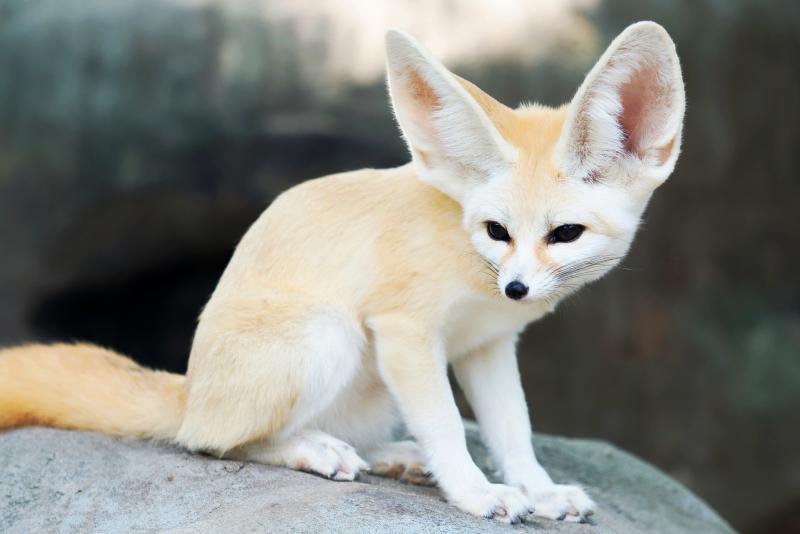
The fennec fox, also known as the desert fox, is a small fox species found in the deserts of North Africa.
Fennec foxes are the smallest species of fox, growing up to 41 cm in length and weighing just 1.5 kg. They have the largest ears relative to their body size, which are used to both aid their hearing and to help them control their body temperature in the hostile environments in which they live.
Fennec foxes are largely nocturnal animals, as this helps protect them from the scorching African heat and keeps them safe from predators during the day. They are adapted to the desert environment with high temperatures and little water. Their coat, ears, and kidney functions have adapted to the desert environment with high temperatures and little water.
Fennec foxes are omnivores, feeding on small rodents, lizards, geckos, skinks, small birds and their eggs, insects, fruits, leaves, roots, and also some tubers.
They make dens beneath stable sand dunes and dig a burrow to sleep in during the heat of the day. They prefer dunes with vegetation nearby. Fennec foxes are monogamous and mate for life. The breeding season runs from January to February, with females giving birth to litters of two to five pups after a gestation period of 50 to 53 days.
Fennec foxes are losing their living spaces due to human activities such as agricultural activities, expanding settlements, and constructing roads. Fennec foxes are hunted by local people for their fur, and in some parts of the world, they are considered an exotic pet.
Quokka
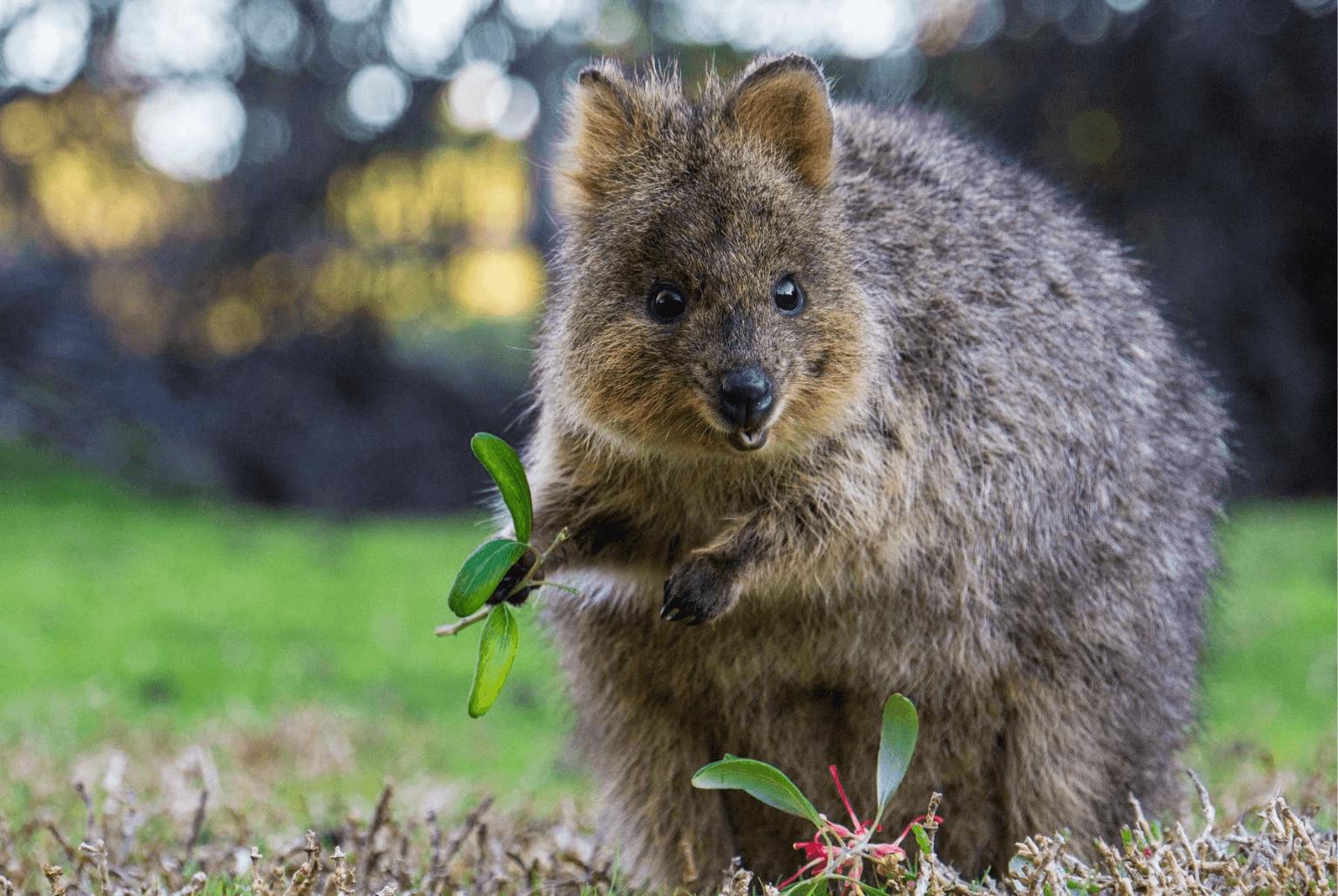
The quokka is a small macropod, about the size of a domestic cat, and the only member of the genus Setonix. It is native to parts of southwest Australia and two nearby islands in the Indian Ocean.
Quokkas have thick grey-brown fur, round faces with black noses and eyes, and teddy-bear ears. They measure 40-54 cm in length and weigh 2.5-5 kg. They are herbivores, eating the leaves, stems, and bark of many plants in addition to grass.
Quokkas are mainly nocturnal animals, feeding at night and sheltering in areas of dense vegetation during the day. They are sociable and friendly animals that inhabit southwestern Australia in small family groups, which are dominated by males. Although they are known to share these habitats peacefully most of the time, fights between males are not unheard of, particularly on a hot day when they compete for the most sheltered spots.
Quokkas have little fear of humans and commonly approach people closely, particularly on Rottnest Island, where they are abundant. Though quokkas are approachable, there are a few dozen cases annually of quokkas biting people, especially children. There are restrictions regarding feeding. It is illegal for members of the public.
The IUCN Red List classifies the quokka as vulnerable due to declining populations and loss of habitat from logging and development. Threats include foxes, dogs, and cats on the mainland, which has limited their population. On Rottnest, there are no foxes, dogs, or cats, but human visitors have killed quokkas out of cruelty.
Quokkas are naturally trusting and curious animals and may approach visitors. If you visit an area with quokkas, do not touch them or feed them. Educate others to do the same. You can also help protect their habitat by supporting efforts to.
FAQS
1. What are the top 10 cutest animals on earth?
The top 10 cutest animals on earth vary depending on the source, but some common animals that appear on many lists include the red panda, koala, meerkat, pygmy marmoset, hedgehog, otter, chevrotain, sea otter, fennec fox, and quokka.
2. Why do humans find baby animals so cute?
According to scientists, humans find baby animals cute because of our powerful nurturing instinct for our children, which spills over into an affection for anything that resembles them. Baby animals have traits of a baby schema, which activates our mesocorticolimbic system, making us squeal with delight at cute critters.
3. Where can I see these cute animals in the wild?
The answer to this question depends on the animal and its habitat. For example, red pandas are found in the eastern Himalayas and southwestern China, while quokkas are found in parts of southwest Australia. Some of these animals can be seen in wildlife parks and zoos around the world.
4. Why are some of these cute animals endangered?
Many of these cute animals are endangered due to habitat loss, human activities such as agricultural activities, expanding settlements, and constructing roads, and hunting or poaching.
5. Can I have one of these cute animals as a pet?
Some of these animals, such as fennec foxes and hedgehogs, are kept as pets in some parts of the world. However, it is important to research the laws and regulations in your area before considering getting one as a pet, as some animals may be illegal to keep as pets or require special permits.
Source: https://petstutorial.com
Category: Animals










